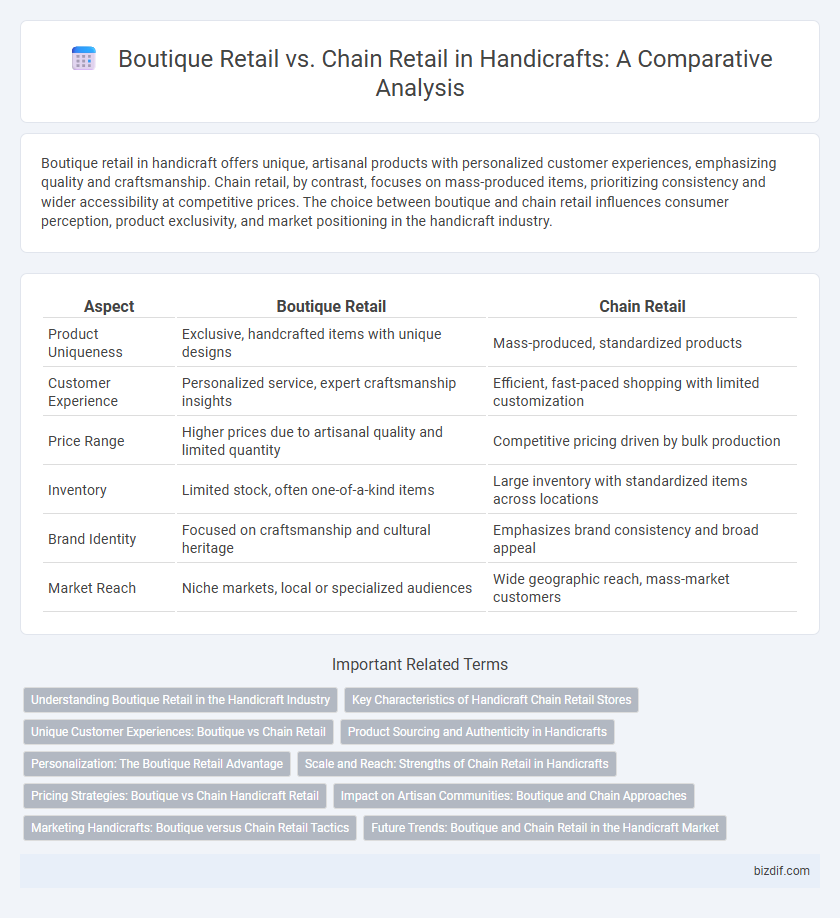Boutique retail in handicraft offers unique, artisanal products with personalized customer experiences, emphasizing quality and craftsmanship. Chain retail, by contrast, focuses on mass-produced items, prioritizing consistency and wider accessibility at competitive prices. The choice between boutique and chain retail influences consumer perception, product exclusivity, and market positioning in the handicraft industry.
Table of Comparison
| Aspect | Boutique Retail | Chain Retail |
|---|---|---|
| Product Uniqueness | Exclusive, handcrafted items with unique designs | Mass-produced, standardized products |
| Customer Experience | Personalized service, expert craftsmanship insights | Efficient, fast-paced shopping with limited customization |
| Price Range | Higher prices due to artisanal quality and limited quantity | Competitive pricing driven by bulk production |
| Inventory | Limited stock, often one-of-a-kind items | Large inventory with standardized items across locations |
| Brand Identity | Focused on craftsmanship and cultural heritage | Emphasizes brand consistency and broad appeal |
| Market Reach | Niche markets, local or specialized audiences | Wide geographic reach, mass-market customers |
Understanding Boutique Retail in the Handicraft Industry
Boutique retail in the handicraft industry specializes in unique, artisanal products that emphasize craftsmanship, cultural heritage, and limited production runs, distinguishing it from mass-produced items found in chain retail stores. These boutiques foster personal customer interactions and provide curated experiences that highlight the story behind each handcrafted piece, enhancing perceived value and exclusivity. Understanding boutique retail's focus on authenticity and niche markets is crucial for artisans seeking to maintain brand identity and command premium pricing.
Key Characteristics of Handicraft Chain Retail Stores
Handicraft chain retail stores typically feature standardized product displays, consistent branding, and centralized inventory management to ensure uniform customer experience across locations. These stores often emphasize scalability and operational efficiency by leveraging bulk purchasing and streamlined supply chains. Unlike boutique retail, chain stores focus on broader market reach, enabling easier access to handicraft items for a diverse customer base.
Unique Customer Experiences: Boutique vs Chain Retail
Boutique retail in handicrafts offers curated, personalized experiences that emphasize artisan stories, exclusive designs, and direct customer interaction, fostering a deep emotional connection. Chain retail prioritizes standardized selection and efficiency, often limiting customization but providing consistent availability and competitive pricing. Unique customer experiences in boutiques nurture brand loyalty through exclusivity, while chains leverage scale for accessibility and product variety.
Product Sourcing and Authenticity in Handicrafts
Boutique retail stores prioritize sourcing handicrafts directly from local artisans, ensuring each product's authenticity and cultural significance. Chain retail often relies on mass-produced or outsourced handicrafts, which can compromise traditional techniques and authenticity. Authenticity in handicrafts is preserved best through close artisan relationships inherent in boutique sourcing strategies.
Personalization: The Boutique Retail Advantage
Boutique retail in handicrafts offers unparalleled personalization by tailoring products and shopping experiences to individual customer preferences, often incorporating custom designs and artisan stories. Unlike chain retail, boutiques foster intimate customer relationships, enhancing satisfaction and loyalty through unique, handcrafted items that reflect cultural heritage and craftsmanship. This personalized approach drives higher perceived value and supports artisans, making boutique retail a preferred choice for discerning consumers seeking authenticity.
Scale and Reach: Strengths of Chain Retail in Handicrafts
Chain retail in handicrafts benefits from extensive scale and reach, enabling widespread distribution across multiple regions and markets. Large chains leverage economies of scale to lower procurement costs and offer competitive pricing on diverse handcrafted products. Their broad network facilitates consistent brand presence and access to a larger customer base compared to smaller boutique retailers.
Pricing Strategies: Boutique vs Chain Handicraft Retail
Boutique handicraft retailers often employ premium pricing strategies that emphasize exclusivity, artisanal quality, and unique craftsmanship, appealing to niche markets willing to pay higher prices. Chain handicraft retailers typically use competitive pricing models driven by economies of scale, volume discounts, and standardized product offerings to attract a broader customer base. Pricing differentiation hinges on the balance between perceived value in boutique stores and mass-market affordability in chain retail environments.
Impact on Artisan Communities: Boutique and Chain Approaches
Boutique retail often prioritizes direct relationships with artisans, providing fair wages and preserving traditional craftsmanship, which strengthens local artisan communities. In contrast, chain retail tends to focus on mass production and lower costs, frequently outsourcing to large manufacturers and diminishing the economic benefits for individual artisans. Supporting boutique retail models helps sustain cultural heritage and promotes economic empowerment within artisan communities.
Marketing Handicrafts: Boutique versus Chain Retail Tactics
Boutique retail in marketing handicrafts emphasizes personalized customer experiences, niche product curation, and storytelling that highlights artisans' unique craftsmanship, fostering strong emotional connections. Chain retail leverages broad distribution channels, standardized branding, and volume-based promotions to maximize reach but often sacrifices the handcrafted authenticity appeal. Effective marketing in handicrafts therefore relies on boutique strategies to maintain product exclusivity and brand identity while utilizing select chain retailers for scalable exposure.
Future Trends: Boutique and Chain Retail in the Handicraft Market
Boutique retail in the handicraft market is expected to grow through personalized customer experiences and limited-edition artisan products, leveraging local culture and heritage to appeal to niche segments. Chain retail will increasingly integrate digital technology and supply chain innovations to scale handcrafted goods while maintaining authenticity through verified provenance systems. Both formats anticipate adopting sustainable practices and advanced e-commerce platforms to meet consumer demand for ethical, artisanal products in the future.
Boutique Retail vs Chain Retail Infographic

 bizdif.com
bizdif.com